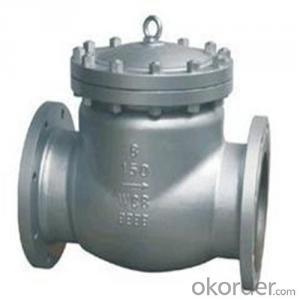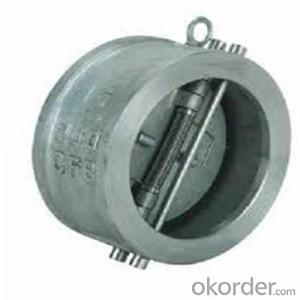API Cast Steel Check Valve 900 Class in Accordance with ISO17292、API 608、BS 5351、GB/T 12237
- Loading Port:
- Shanghai
- Payment Terms:
- TT OR LC
- Min Order Qty:
- 10 pc
- Supply Capability:
- 100 pc/month
OKorder Service Pledge
OKorder Financial Service
You Might Also Like
The features of check valve
Bolted Bonnet;Swing and lift disc;Metallic seating surfaces.
Body and Bonnet Connection
The body and bonnet of Class150~Class900 check valves are usually with studs and nuts.And the body and bonnet of Class1500~Class2500 check valves are usually of pressurized seal design.
Body-To-Bonnet Joint
Stainless steel + flesible graphite wounded gasket is used for Class 150 and Class 300 check valve;Stainless steel + flexible graphite wounded gasket is used for Class 600 check valve,and joint gasket is also optional for Class 600 check valve;Ring joint gasket is used for Class900 check valve;Pressurized seal design is used for Class 1500~Class 2500 check valves.
Seat
For carbon steel check valve,the seat is usually forged steel.The sealing surface of the seat is spray welded with hard alloy specified by the customer.Renewable threaded seat is used for NPS<10 check valves ,and welded on seat can be also optional if being requested by the customer.Welded on seat is used for NPS>12 crbon steel gate valves .Forstainless steel check valve,integral seat is usually adopted ,or to weld hard alloy directly integrally.Threaded or welded on seat is also optional for stainless steel check valve if being requested by the customer.
Standard Criteria | ASME/ANSI/API customize |
Pressure Rating | 150 Class 300 Class 600 Class 900 Class 1500 Class 2500 Class customize |
Valve Size | 50 mm 65 mm 80 mm 100 mm 125 mm 150 mm 200 mm 250 mm 300 mm 350 mm 400 mm 450 mm 500 mm 600 mm 650 mm 700 mm 750 mm |
2 inch 2.5 inch 3 inch 4 inch 5 inch 6 inch 8 inch 10 inch 12 inch 14 inch 16 inch 18 inch 20 inch 24 inch 26 inch 28 inch 30 inch customize | |
Actuator | Automatic customize |
Connection | Butt Welding Flange RF Flange RTJ customize |
1-Body Material | A216 WCB A351-CF8 A351-CF8M customize |
2-Seat ring | A105+13Cr A351-CF8M A351-CF8 A105+Tool Steel customize |
3-Disc | 13Cr+A216 WCB A351-CF8 A351-CF8M Tool Steel+A216 WCB customize |
4-Arm | A351-CF8M A216 WCB A351-CF8 customize |
5-Nut | A194-8 A194 2H A194 8M customize |
6-Arm pin | A182-F316 A182-F6a A182-F304 customize |
7-Yoke | A351-CF8M A216 WCB A351-CF8 customize |
8-Bonnet nut | A194 2H A194 8M A194-8 customize |
9-Bonnet bolt | A193-B8 A193-B8M A193-B7 customize |
10-Bolt | A193-B8 A193-B7 A193-B8M customize |
11-Gasket | graphite+304 316+graphite customize |
12-Bonnet | A351-CF8 A216 WCB A351-CF8M customize |
13-Eye bolt | A181 customize |
Design Standard | API 6D BS 1868 customize |
Connection Standard | API 605 ASME B 16.25-2007 ASME B 16.47A ASME B 16.47B ASME B 16.5 MSS SP-44 customize |
Test Standard | API 598 API 6D customize |
Face to Face | ASME B 16.10 customize |
Pressure-temperature ratings | ASME B 16.34-2004 customize |
Wall thickness dimension | API 600 BS 1868 customize |
- Q: Alright. The engine is a 7mgte. The clearances for the skims in the intake side is 0.20mm and the exh side is 0.25mm. What happens if i mixed the shims?
- I somewhat have a 2003 Honda XR 250 and the bike is great; low upkeep for a airborne dirt and dirt bike. The XR 450 has the comparable engine layout. it is going to be a solid bike. i will?t remark on a yamaha. the hot crf 450 desires lots extra upkeep than the xr 450.
- Q: I got a 2012 peterbilt 386 ...it just came back from the shop a few day ago to get injectors 4 and 5 looked at and repaired ....I'm getting a fault code for injector spill valve and a engine light ....I tried resetting the computer to get rid of the code but that's not it ... uld timeing of this cause the problem ...but other than that it runs like a champ so what could I do to fix this is it time cause I did probably get re timed when they repaired it
- The fault for the spill valve is not something you can correct with timing. When they repaired or replace injectors they need to be programed into the computer so they match the other injectors. The spill valve is in the injector and is there to return unneeded fuel back to tank. If this valve does not work you could be over fueling or run the risk of fuel cooking in the injector making a mess of the spray pattern. It should be telling you which injector is throwing the code and if it is one of the two that were worked on take it back.
- Q: I have a 2000 jeep grand cherokee v8 4.7L it has a stuck valve making knocking noises my question is can i still drive it !? or is too dangerous
- For 1 how do you know it has a stuck valve , if you know that you know how to get it unstuck (pb-blaster ) or something like that , or is it carbon holding it open if it is you will need to pull the head becouse the head of the valve will come off and damage the piston and the block , good luck.30 years exp on cars and big trucks
- Q: We live in a four story sixteen unity apartment building. There are two radiators in our apartment. The on in the living room is large and we can't turn it on with out water coming out of the little valve on the end, which I am assuming is there to release excess pressure. It doesn't matter if we leave it on for an hour or two days—water still comes out. It has warped the wood below it.How can I stop this? I would really like to have heat on both sides of my apartment.Thanks!
- Melvin S is correct. But check to see if the valve is closed first.
- Q: does anyone know how much work it would take for a 1998 Mazda 626 (2.0L MFI DOHC) to change a bad intake valve?what work would be necessary and what kind of price are we talkin?
- if you have did a compression check and know for a fact that the valve is bad the head has to be removed and then checked for leakage and cracks before you install it back on,those was bad to produce small cracks between the valve guides,if it checks ok then have the valve replaced,the cost should be about 600-700 on doing this one,that was a good engine those cars had in them,good luck.
- Q: 1990 Pontiac Sunbird 2.0L Fuel Injected has EGR Valve, I can suck and blow through the hose connected to it, an I supposed to be able to do this, or not...? It looks old, like it's been on the car forever...
- It recirculates the fumes and the air--but a cracked hose is a nightmare if vacuum leak develops--fix it--just get a new hose and happy motoring
- Q: 1990 5.7l with a .470 lift cam , is there going to be a clearance issue between the valve guide and the valve. Is the rocker going to bottom out on the guides and bust my heads.. If so what should i do.
- difficult factor. query on to search engines like google. that will can assist!
- Q: And' the valve leaks......Can the valve be unscrewed from the tank for replacement? Or can the valve be serviced with a new gasket perhaps?
- i would not worry about replacing the wsher inside the valve...U can go to about any home improvement store and just buy a new valve for around $10...so if they have a quarter turn valve...those will serve u best in the future plus it is a ball valve which doesnt use a washer but a ball inside turn so it is a better seal...just drain the water heater then unscrew the old one and put pipe sealant on the thread of the new one and just screw it back in and fill ur water heater back up and ur done..
- Q: -air pressure of 40 psi only -run on 12v or 250 vac-no need for half open or any of the options i just want it on or off-it will be for a costum use so i dont need any special designs for it any thing will work -it also can be change from gas to water if
- With okorder and buy one on-line for about $25 and get it in a couple days. Look for thermoplastic valves rather than brass ones, you will save a lot of cash that way. And by the way, if this is really for costume use, you really do not want to use 250vac. That will fry your butt for sure. Stick with the 12vdc.
- Q: I got a new gas stove, but I can't find a shut off valve to take the old one out and put the new one in. There isnt one behind the stove on the line, and i went under the house and followed the gasline and didnt find one down there either. Can any one give me ideas where else to look?
- call the gas company and they can help, probably shut the gas off at the meter
Send your message to us
API Cast Steel Check Valve 900 Class in Accordance with ISO17292、API 608、BS 5351、GB/T 12237
- Loading Port:
- Shanghai
- Payment Terms:
- TT OR LC
- Min Order Qty:
- 10 pc
- Supply Capability:
- 100 pc/month
OKorder Service Pledge
OKorder Financial Service
Similar products
Hot products
Hot Searches
Related keywords



























